GE WSSH300 User Manual

WashersSpacemaker
ge.com
Safety Instructions . . . . . . . . . . . . 2–4
Operating Instructions
Control Panels . . . . . . . . . . . . . . . . . . . . . . . 5
Control Settings . . . . . . . . . . . . . . . . . . . . . .5
Fabric Care Labels . . . . . . . . . . . . . . . . . .10
Features . . . . . . . . . . . . . . . . . . . . . . . . . . .6, 7
Loading and Using the Washer . . . . . .8, 9
Installation Instructions . . . . .11–16 Drain Requirements . . . . . . . . . . . . . . . . .14 Electrical Requirements . . . . . . . . . . . . . .14 Installing the Washer . . . . . . . . . . . . .15, 16 Location of Your Washer . . . . . . . . . . . . .12 Preparing to Install Your Washer . . . . . .11 Replacement Parts . . . . . . . . . . . . . . . . . .16 Rough-In Dimensions . . . . . . . . . . . . . . . .12 Unpacking Your Washer . . . . . . . . . . . . .13 Water Supply Requirements . . . . . . . . . .14
Troubleshooting Tips . . . . . . . .17–20
Consumer Support
Consumer Support . . . . . . . . . . . . . . . . . . 24
Warranty . . . . . . . . . . . . . . . . . . . . . . . . . . 23
As an ENERGY STAR® partner, GE has determined that this
product meets the ENERGY STAR® guidelines for energy efficiency.
Owner’s Manual &
Installation Instructions
WSSH300
134867100 175D1807P580 49-90312-1 01-07 JR

Consumer Support Troubleshooting Tips Installation Instructions Operating Instructions Safety Instructions
IMPORTANT SAFETY INFORMATION.
READ ALL INSTRUCTIONS BEFORE USING.
WARNING! For your safety, the information in this manual must be followed to minimize the risk of fire or explosion, electric shock, or to prevent property damage, personal injury, or
loss of life.
The instructions in this manual and all other literature included with this washer are not meant to cover every possible condition and situation that may occur. Good, safe practices and caution MUST be applied when installing, operating, and maintaining any appliance.
 WATER HEATER SAFETY
WATER HEATER SAFETY
Under certain conditions, hydrogen gas may be produced in a water heater that has not been used for two weeks or more. Hydrogen gas can be explosive under these circumstances.
If the hot water has not been used for two weeks or more, prevent the possibility of damage or injury by turning on all hot water faucets and allowing them to run for several minutes. Do this before using any electrical appliance which is connected to the hot water system. This simple procedure will allow any built-up hydrogen gas to escape. Since the gas is flammable, do not smoke or use an open flame or appliance during this process.
2

PROPER INSTALLATION
This washer must be properly installed and located in accordance with the Installation Instructions before it is used.
■ Install or store where it will not be exposed to |
■ Properly ground washer to conform with all |
temperatures below freezing or exposed to the |
governing codes and ordinances. Follow details in |
weather. |
Installation Instructions. |
YOUR LAUNDRY AREA
■ Keep the area underneath and around your |
■ Close supervision is necessary if this appliance is |
appliances free of combustible materials such as |
used by or near children. Do not allow children to |
lint, paper, rags and chemicals. |
play on, with, or inside this or any other appliance. |
■Do not leave the washer door open. An open door could entice children to hang on the door or crawl inside the washer.
3
Support Consumer Tips Troubleshooting Instructions Installation Instructions Operating Instructions Safety

Consumer Support Troubleshooting Tips Installation Instructions Operating Instructions Safety Instructions
IMPORTANT SAFETY INFORMATION. READ ALL INSTRUCTIONS BEFORE USING.
WHEN USING THE WASHER
Use this appliance only for its intended purpose as described in this Owner’s Manual.
■Never reach into washer while it is moving. Wait until the machine has completely stopped before opening the door.
■Do not mix chlorine bleach with ammonia or acids such as vinegar and/or rust remover. Mixing different chemicals can produce a toxic gas which may cause death.
■Do not wash or dry articles that have been cleaned in, washed in, soaked in, or spotted with combustible or explosive substances (such as wax, oil, paint, gasoline, degreasers, drycleaning solvents, kerosene, etc.) which may ignite or explode. Do not add these substances to the wash water. Do not use or place these substances around your washer or dryer during operation.
■The laundry process can reduce the flame retardancy of fabrics. To avoid such a result, carefully follow the garment manufacturer’s wash and care instructions.
■To minimize the possibility of electric shock, unplug this appliance from the power supply or disconnect the washer at the household distribution panel by removing the fuse or switching off the circuit breaker before attempting any maintenance or cleaning. NOTE: Pressing the PAUSE button does NOT disconnect the appliance from the power supply.
■Never attempt to operate this appliance if it is damaged, malfunctioning, partially
disassembled, or has missing or broken parts, including a damaged cord or plug.
■Do not slam the washer door closed or try to force the door open when locked (Door Lock light ON). This could result in damage to the washer.
■The washer is equipped with an electrical overload protector. The motor will stop if it becomes overheated. The washer will automatically restart after a cool-down period of up to 30 minutes, if the washer has not been manually turned off during this time.
WHEN NOT IN USE
■Turn off water faucets to relieve pressure on hoses and valves and to minimize leakage if a break or rupture should occur. Check the condition of the fill hoses; they should be replaced every 5 years.
■Before discarding a washer, or removing it from service, remove the washer door to prevent children from hiding inside.
■Do not attempt to repair or replace any part of this appliance unless specifically recommended in this Owner’s Manual, or in published userrepair instructions that you understand and have the skills to carry out.
■Do not tamper with controls.
 READ AND FOLLOW THIS SAFETY INFORMATION CAREFULLY.
READ AND FOLLOW THIS SAFETY INFORMATION CAREFULLY.


 SAVE THESE INSTRUCTIONS
SAVE THESE INSTRUCTIONS
4
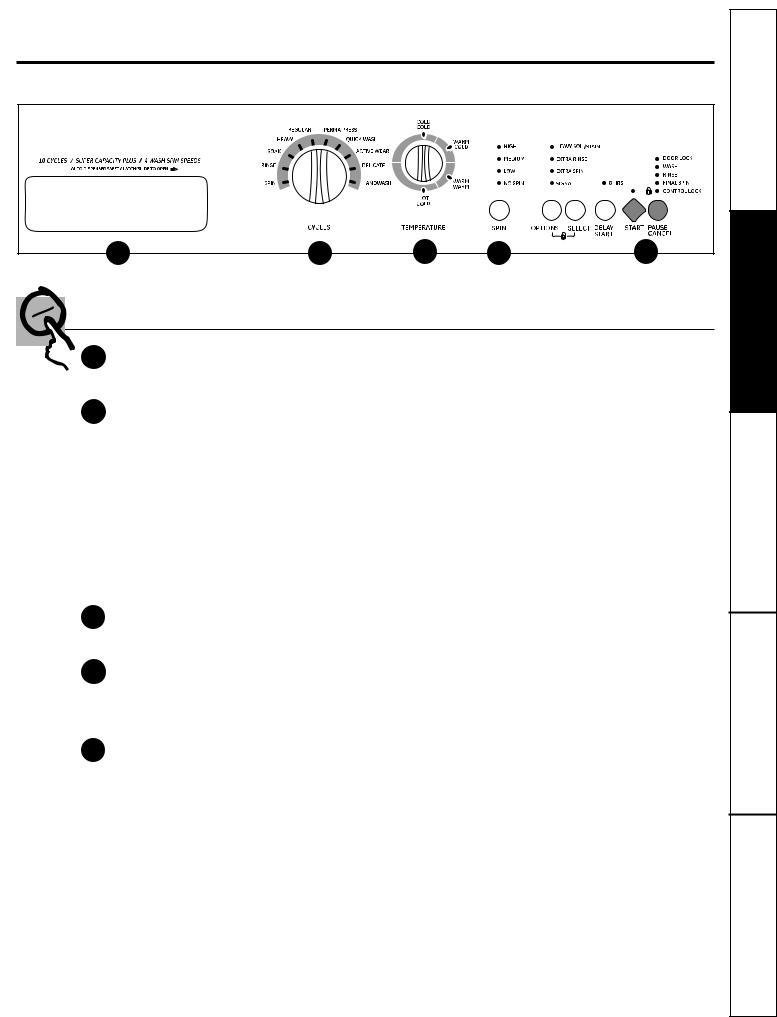
About the washer control panel.
You can locate your model number at the top inside of the door opening.
1 2 3 4
Settings
1 |
|
left on its own.) Add detergent, |
|
|
|
||
|
liquid bleach and fabric softener to this drawer. |
|
|
2 |
Wash Cycle |
|
the |
|
The wash cycle controls the length of the washing process. The chart below will help you |
||
|
wash cycle setting with your loads. Set the desired wash cycle by turning the cycle knob. |
|
|
|
|
|
|
|
HANDWASH |
For items labeled hand-washable with light soils. Provides gentle rocking to mimic the handwashing action. |
|
|
|
|
|
|
DELICATE |
For lingerie and special-care fabrics with light to normal soil. Provides gentle tumbling and |
wash |
|
|
and rinse. |
|
|
ACTIVE WEAR |
For active sports, exercise and some casual wear clothes. Fabrics include modern technology |
and |
|
|
fibers such as spandex, stretch and micro-fibers. |
|
|
QUICK WASH |
For lightly soiled items you need in a hurry. |
|
|
|
|
|
|
PERMA PRESS |
For wrinkle-free and permanent press items. |
|
|
|
|
|
|
HEAVY |
For heavily soiled cottons, household linens, work and play clothes. |
|
3 |
Temperature |
|
|
|
Select the water temperature for the wash and rinse cycles. Always follow garment manufacturer’s |
||
|
care label or instructions when laundering. |
|
|
4 |
Spin Speed |
|
|
|
The HIGH spin speed is for durable items. |
|
|
|
The MEDIUM spin speed is for delicate items like sweaters and lingerie. |
|
|
|
When using the MEDIUM spin speed, clothes will be less dry than when using the HIGH spin speed. |
||
5 |
START/PAUSE CANCEL |
|
|
|
Start the washer by closing the door and pressing the START button. |
|
|
To stop the washer, press the PAUSE CANCEL button. Press the START button to restart.
■The washer will not operate with the door open.
■The door will automatically lock during the entire wash cycle.
5
Support Consumer Tips Troubleshooting Instructions Installation Instructions Operating Instructions Safety

Consumer Support Troubleshooting Tips Installation Instructions Operating Instructions Safety Instructions
About the washer features.
Signal
When the Signal is ON, it will sound at the end of the cycle.
Extra Rinse
(available on some cycles)
Use an extra rinse when additional rinsing is desired to remove excess dirt and detergent from soiled loads.
Door Lock Indicator Light
The indicator light is ON and the door is locked when the START button is pressed. The light turns OFF at the end of the cycle.
Control Lock
To prevent accidentally starting or stopping the washer, press OPTIONS and SELECT at the same time until the Control Lock indicator is lighted. To unlock the controls, press OPTIONS and SELECT again.
6
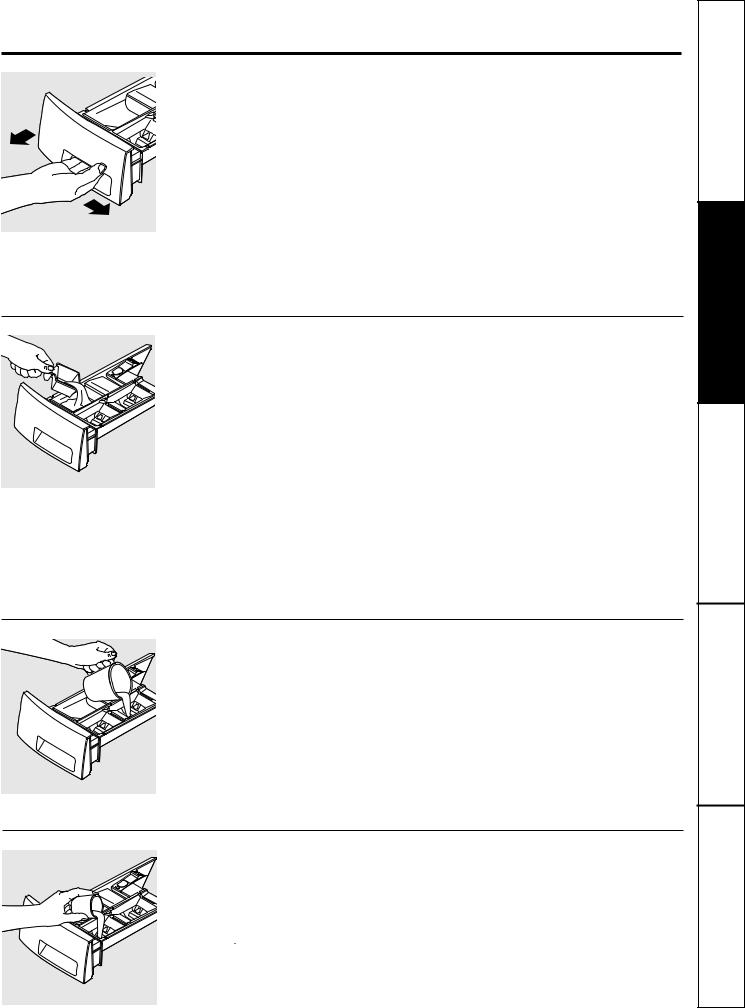
The Dispenser Drawer
Slowly open the dispenser drawer by first sliding the safety latch to the right, then pulling the drawer out until it stops.
After adding laundry products, slowly close the dispenser drawer. Closing the drawer too quickly could result in early dispensing of the bleach and fabric softener.
You may see water in the bleach and fabric softener compartments. This is a result of the siphoning action and is part of the normal operation of the washer.
 If the dispenser drawer is pulled out more than 1-1/2” when the washer is in operation, the washer will shut off. The
If the dispenser drawer is pulled out more than 1-1/2” when the washer is in operation, the washer will shut off. The
DOOR LOCK indicator light will turn off and the door will be unlocked. Slowly close the drawer, and the washer will automatically resume operation.
The Detergent Compartment
■Add measured detergent to the detergent compartment of the dispenser drawer.
■Detergent is flushed from the dispenser at the beginning of the cycle. Either powdered or liquid detergent can be used.
NOTE: Liquid detergent will drain into the washer drum as it is added.
■Low sudsing detergent is recommended for this washer. Use the manufacturer’s recommended amount.
■Detergent usage may need to be adjusted for water temperature, water hardness, size and soil level of the load. Avoid using too much detergent in your washer as it can lead to oversudsing and detergent residue being left on the clothes.
■Color-safe bleach, water conditioner, detergent booster and enzyme products may be added to the detergent compartment. Avoid mixing liquids and powders.
■If the dispenser drawer is opened during operation, the washer will shut off. Slowly close the dispenser drawer, and press START to continue cycle.
The Liquid Bleach Compartment
If desired, measure out the recommended amount of liquid chlorine bleach, not to exceed 1/3 cup (80 ml) and pour into the center compartment labeled “LIQUID BLEACH” marked with this symbol  .
.
Fill to the minimum fill line (MIN.) for small loads.
Do not exceed the maximum fill line. Overfilling can cause early dispensing of the bleach which could result in damaged clothes.
NOTE: Do not use powdered bleach in the dispenser.
The Fabric Softener Compartment
If desired, pour the recommended amount of liquid fabric softener into the compartment labeled “FABRIC SOFTENER” and marked with this symbol  .
.
Fill to the minimum fill line (MIN.) for small loads. Fill to the maximum fill line (MAX.) for large loads.
Dilute with water to the maximum fill line.
Do not exceed the maximum fill line. Overfilling can cause early dispensing of the fabric softener which could stain clothes.
NOTE: Do not pour fabric softener directly on the wash load.
7
Support Consumer Tips Troubleshooting Instructions Installation Instructions Operating Instructions Safety
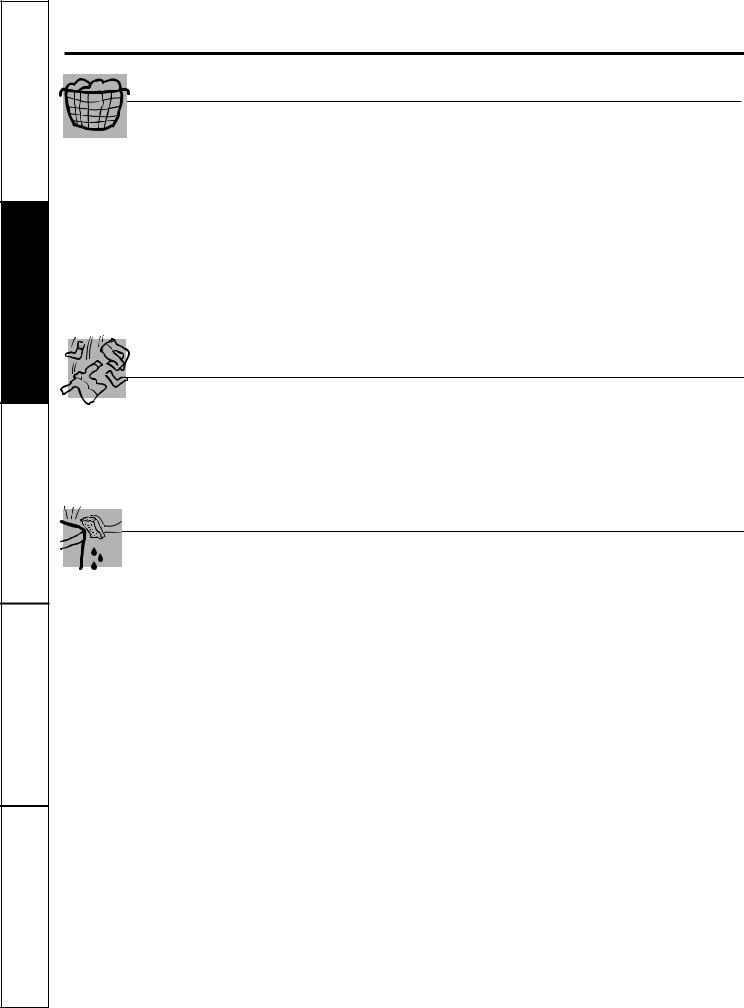
Consumer Support Troubleshooting Tips Installation Instructions Operating Instructions Safety Instructions
Loading and using the washer. Always follow fabric manufacturer’s care label when laundering.
Sorting Wash Loads
Sort laundry into loads that can be washed together.
Colors |
Soil |
Fabric |
Lint |
Whites |
Heavy |
Delicates |
Lint Producers |
Lights |
Normal |
Easy Care |
Lint Collectors |
Darks |
Light |
Sturdy Cottons |
|
■Combine large and small items in a load. Load large items first. Large items should not be more than half the total wash load.
■Do not wash single items. This may cause an out-of-balance load. Add one or two similar items.
Loading the Washer
Wash drum may be fully loaded with loosely |
To add items after washer has started, press the |
added items. Do not wash fabrics containing |
PAUSE CANCEL button and wait until there is no |
flammable materials (waxes, cleaning fluids, etc.). |
longer any water on the door window. Do not |
|
force open the locked door; open gently. Add |
|
items, close the door and press the START button. |
Care and Cleaning
Exterior: Immediately wipe off any spills. Wipe with damp cloth. Try not to hit surface with sharp objects.
Interior: Dry around the washer door opening, flexible gasket and door glass. These areas should always be clean to ensure a water tight seal.
Moving and Storage: Ask the service technician to remove water from drain pump and hoses. Do not store the washer where it will be exposed to the weather. When moving the washer, the tub should be kept stationary by using the brackets and bolts removed during installation. See Installation Instructions in this book. If these parts are not available, they can be ordered by visiting our Website at ge.com or by calling 800.GE.CARES.
Long Vacations: Be sure water supply is shut off at faucets. Drain all water from hoses if weather will be below freezing.
8
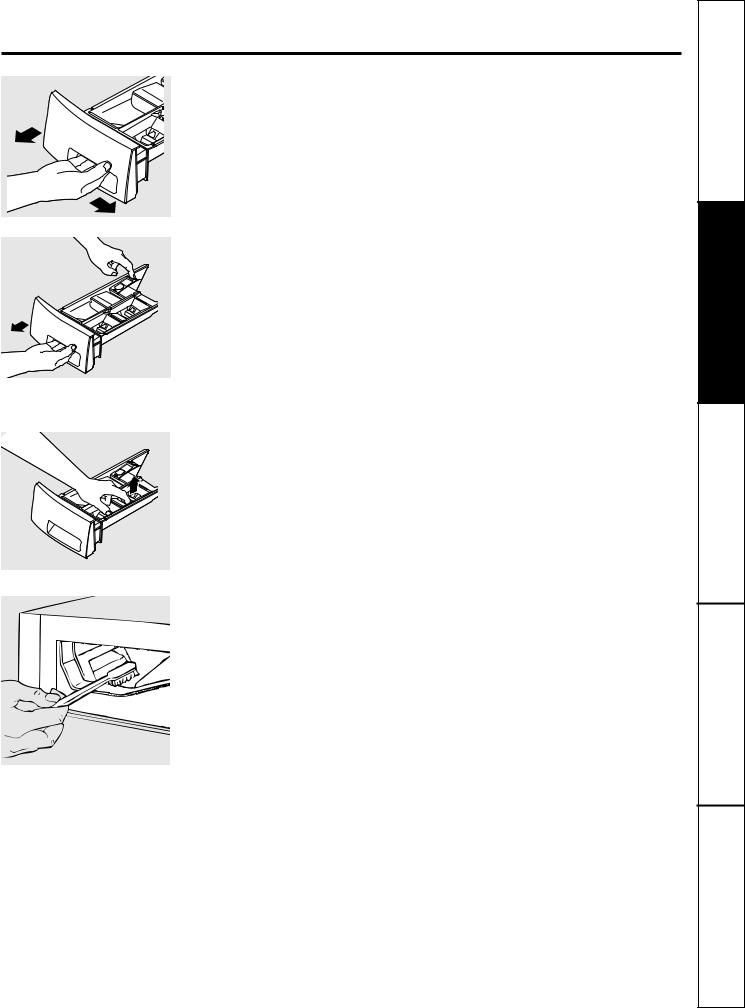
Lock tab is visible only after drawer has been pulled out
Dispenser Drawer Area: Detergent and fabric softener may build up in the dispenser drawer. Residue should be removed once or twice a month.
■Remove the drawer by first sliding the safety latch to the right, then pulling the drawer out until it stops. Reach back into the left rear corner of the drawer cavity and press down firmly on the lock tab, pulling out the drawer.
■Remove the inserts from the bleach and fabric softener compartments. Rinse the inserts and the drawer with hot water to remove traces of accumulated laundry products.
■To clean the drawer opening, use a small brush to clean the recess. Remove all residue from the upper and lower parts of the recess.
NOTE: Large amounts of fabric softener residue may indicate improper dilution or that more frequent cleaning is required.
■Return the bleach and fabric softener inserts to the proper compartments. Replace the insert, pressing the “X” to lock it in place. Replace the dispenser drawer and run the QUICK WASH cycle without any wash load in the drum.
9
Support Consumer Tips Troubleshooting Instructions Installation Instructions Operating Instructions Safety
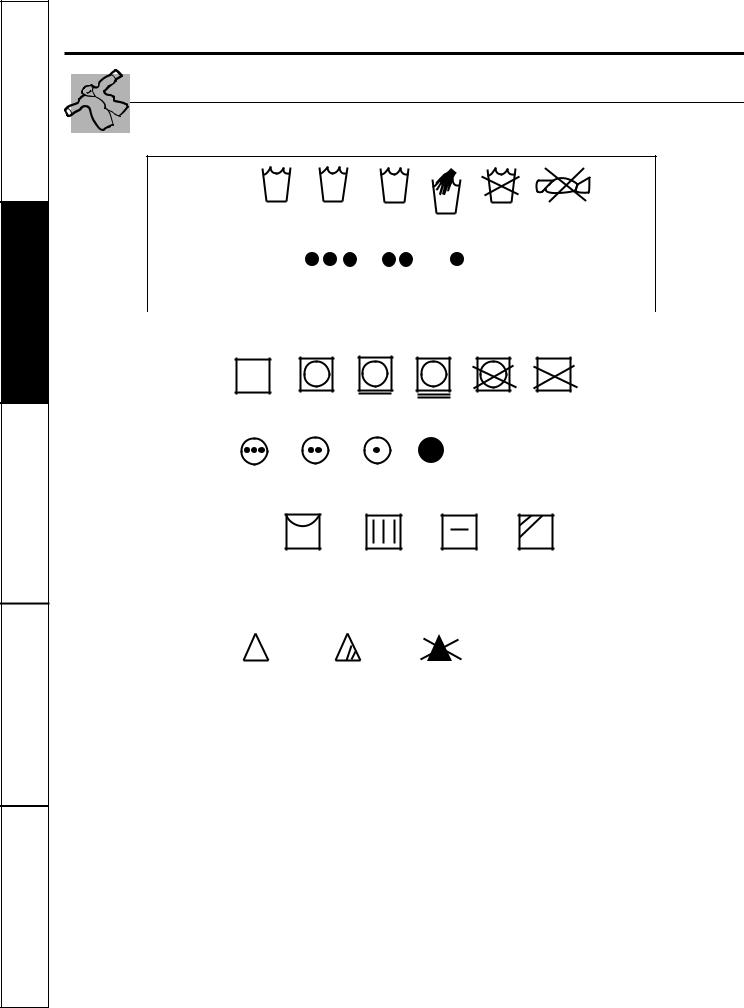
Consumer Support Troubleshooting Tips Installation Instructions Operating Instructions Safety Instructions
About the washer features.
Fabric Care Labels
Below are fabric care label “symbols” that affect the clothing you will be laundering.
WASH LABELS
Machine wash
cycle |
Normal |
|
|
|
|
|
|
|
|
|
Permanent Press/ |
|
|
|
|
Do not wash |
Do not wring |
||||
|
Gentle/ |
|
Hand wash |
|||||||
|
|
wrinkle resistant |
delicate |
|
|
|
||||
Water |
|
|
|
|
|
|
|
|
|
|
temperature |
|
Hot |
|
Warm |
Cold/cool |
|
|
|||
|
|
(50°C/120°F) |
(40°C/105°F) (30°C/85°F) |
|
|
|||||
|
|
|
|
|
|
|
|
|
|
|
DRY LABELS |
|
|
|
|
|
|
|
|
|
|
|
|
|
|
|
|
|
|
|
|
|
Tumble |
|
|
|
|
|
|
|
|
|
|
dry |
|
|
|
|
|
|
|
|
|
Do not dry |
|
Dry |
Normal Permanent Press/ |
|
|
||||||
|
Gentle/ Do not tumble dry |
(used with |
||||||||
|
|
|
|
wrinkle resistant |
delicate |
|
do not wash) |
|||
Heat |
|
|
|
|
|
|
|
|
|
|
setting |
|
|
|
|
|
|
|
|
|
|
|
High |
Medium |
Low |
No heat/air |
|
|
||||
Special |
|
|
|
|
|
|
|
|
|
|
instructions |
|
|
|
|
|
|
Dry flat |
|
|
|
|
Line dry/ |
Drip dry |
In the shade |
|||||||
|
hang to dry |
|
|
|
|
|
|
|||
|
|
|
|
|
|
|
|
|
|
|
BLEACH LABELS |
|
|
|
|
|
|
|
|
|
|
|
|
|
|
|
|
|
|
|
|
|
Bleach |
|
|
|
|
|
|
|
|
|
|
symbols |
Any bleach |
Only non-chlorine bleach |
Do not bleach |
|
|
|||||
|
(when needed) |
(when needed) |
|
|
|
|||||
|
|
|
|
|
|
|
|
|
|
|
10
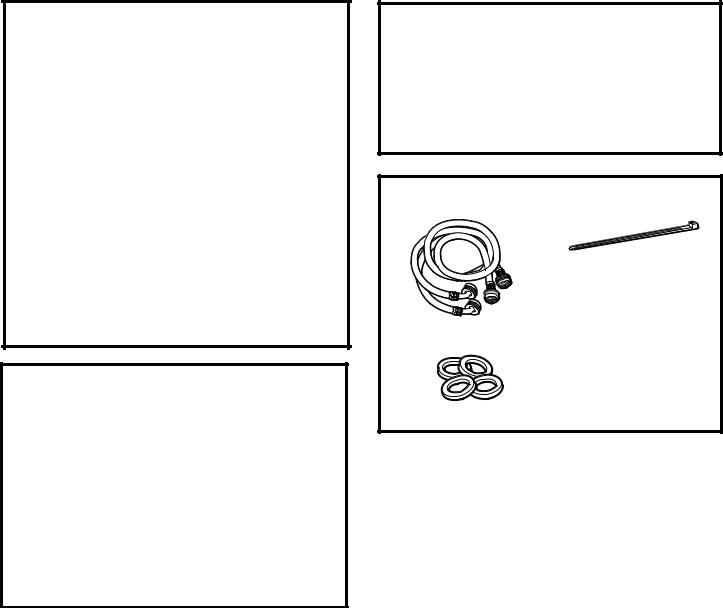
Installation |
Spacemaker Washer |
Instructions |
Model WSSH300 |
|
|
|
|
|
|
If you have any questions, call 800.GE.CARES (800.432.2737) or visit our Website at: ge.com |
|
|
|
BEFORE YOU BEGIN
Read these instructions completely and carefully.
• IMPORTANT – Save these
instructions for local inspector’s use.
• IMPORTANT – Observe all
governing codes and ordinances.
• Note to Installer – Be sure to leave these instructions with the Consumer.
• Note to Consumer – Keep these instructions for future reference.
•Skill level – Installation of this appliance requires basic mechanical and electrical skills.
•Completion time – 1-3 hours
•Proper installation is the responsibility of the installer.
•Product failure due to improper installation is not covered under the Warranty.
FOR YOUR SAFETY:
 WARNING
WARNING
•This appliance must be properly grounded and installed as described in these Installation Instructions.
•Do not install or store appliance in an area where it will be exposed to water/weather. See Location of Your Washer section.
•NOTE: This appliance must be properly grounded, and electrical service to the washer must conform with local codes and ordinances and the latest edition of the National Electrical Code, ANSI/NFPA 70.
TOOLS REQUIRED FOR WASHER INSTALLATION
Phillips screwdriver
10 mm socket with ratchet
Channel-lock adjustable pliers
Carpenter’s level
PARTS SUPPLIED
Cable Tie
Water Hoses (2)
Rubber Washers (4)
11

Installation Instructions
LOCATION OF YOUR WASHER
Do Not Install the Washer:
1.In an area exposed to dripping water or outside weather conditions. The ambient temperature should never be below 60°F (15.6°C) for proper washer operation.
2.In an area where it will come in contact with curtains or drapes.
3.On carpet. The floor MUST be a hard surface with a maximum slope of 1/2″ per foot (1.27 cm per 30 cm). To make sure the washer does not vibrate or move, you may have to reinforce the floor.
IMPORTANT:
Minimum Installation Clearances
•When installed in alcove: Sides, Rear, Top = 0″ (0 cm)
•When installed in closet: Sides, Rear, Top = 0″ (0 cm), Front = 1″ (2.54 cm)
•Closet door ventilation openings required:
2 louvers each 60 square in. (387 cm2), located 3″ (7.6 cm) from top and bottom of door
Undercounter Installation
If an undercounter installation is desired, a custom-sized countertop is required (36″ to the underside of the countertop). No special washer top is required.
Mobile Home Installation
Installation must conform to Standard for Mobile Homes, ANSI A119.1 and National Mobile Home Construction and Safety Standards Act of 1974 (PL93-383).
Stacked Installation
If a stacked washer/dryer installation is desired, you MUST use Stacking Kit WE25X10020. This kit is available through your GE retailer.
ROUGH-IN DIMENSIONS |
|
||
|
|
273⁄4″ |
|
|
|
(70.5 cm) |
|
33⁄4″ |
|
24″ |
60″ |
(9.5 cm) |
|
(61 cm) |
(152.4 cm) |
|
|
|
Power Cord |
|
|
|
333⁄8″ |
|
|
|
(84.8 cm) |
|
|
SIDE |
|
|
|
27″ |
|
|
81⁄2″ |
(68.6 cm) |
63⁄4″ |
|
|
||
|
(21.6 cm) |
|
(17.1 cm) |
36″ |
23⁄4″ |
|
|
(91.3 cm) |
|
|
|
|
(7 cm) |
|
|
|
|
|
Water Inlets |
|
|
|
331⁄2″ |
Drain |
|
|
(85.1 cm) |
|
|
|
|
321⁄4″ |
|
|
|
(81.9 cm) |
|
|
|
|
|
REAR |
|
12
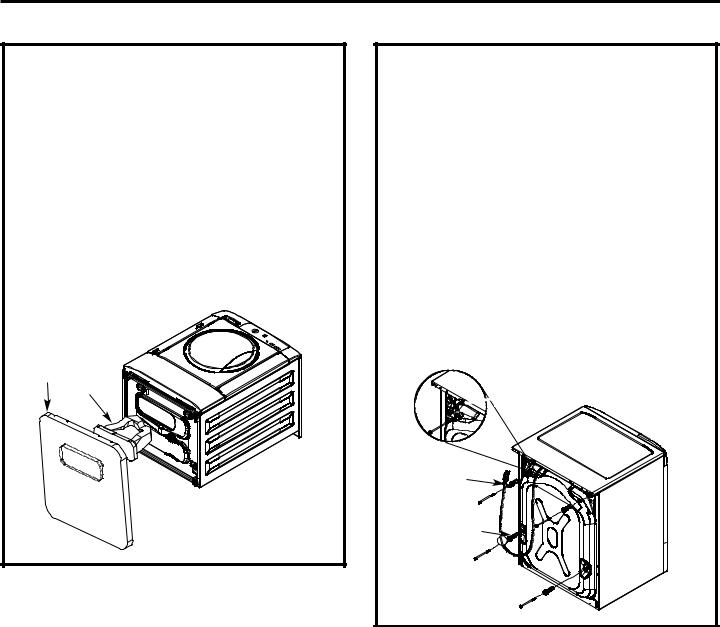
Installation Instructions
UNPACKING THE WASHER
 WARNING: Destroy the carton and plastic bags after the washer is unpacked. Children might use them for play. Cartons covered with rugs, bedspreads, or plastic sheets can become airtight chambers causing suffocation. Place all materials in a garbage container or make materials inaccessible to children.
WARNING: Destroy the carton and plastic bags after the washer is unpacked. Children might use them for play. Cartons covered with rugs, bedspreads, or plastic sheets can become airtight chambers causing suffocation. Place all materials in a garbage container or make materials inaccessible to children.
1.Cut the shipping carton along the dotted line along the bottom. Remove the carton.
2.Using a rug, blanket or piece of cardboard to protect the floor, lay the washer on its back.
3.Remove and save the styrofoam base and shipping plug.
Base
Shipping
Plug
4.Carefully return the washer to an upright position.
5.Carefully move the washer to within 4 feet (122 cm) of the final location.
6.Remove the following from the back panel of the washer:
4shipping bolts
4spacers
1metal “P” clamp
7.Remove the 4 plugs from the literature pack located in the drum and install them in the holes vacated by the packaging spacers.
Save all bolts, washers, spacers, brackets, clamps and blocks for future use.
NOTE: If you must transport the washer at a later date, you must reinstall the shipping support hardware to prevent shipping damage. Keep the hardware in the plastic bag provided.
 Power Cord
Power Cord
Metal “P” Clamp
4 Shipping Bolts
4 Spacers |
13

Installation Instructions
ELECTRICAL REQUIREMENTS
Read these instructions completely and carefully.
CIRCUIT – Individual, properly polarized and grounded 15-amp branch circuit fused with 15-amp time-delay fuse or circuit breaker.
POWER SUPPLY – 2-wire, with ground, 120-volt, singlephase, 60-Hz, Alternating Current.
OUTLET RECEPTACLE – Properly grounded
3-prong receptacle to be located so the power supply cord is accessible when the washer is in an installed position.
GROUNDING REQUIREMENTS
 WARNING: Improper connection of the equipment grounding conductor can result in a risk of electrical shock. Check with a licensed electrician if you are in doubt as to whether the appliance is properly grounded.
WARNING: Improper connection of the equipment grounding conductor can result in a risk of electrical shock. Check with a licensed electrician if you are in doubt as to whether the appliance is properly grounded.
1.The washer MUST be grounded. In the event of malfunction or breakdown, grounding will reduce the risk of electrical shock by providing a path of least resistance for electrical current.
2.Since your washer is equipped with a power supply cord having an equipment-grounding conductor and a grounding plug, the plug MUST be plugged into an appropriate, copper-wired receptacle that is properly installed and grounded in accordance with all local codes and ordinances or in the absence of local codes, with the National Electrical Codes, ANSI/NFPA 70 (latest edition). If in doubt, call a licensed electrician. DO NOT cut off or alter the grounding prong on the power supply cord. In situations where a two-slot receptacle is present, it is the owner’s responsibility to have a licensed electrician replace it with a properly grounded three-prong grounding-type receptacle.
WATER SUPPLY REQUIREMENTS
Hot and cold water faucets MUST be installed within 42 inches (107 cm) of your washer’s water inlet. The faucets MUST be 3/4″ (1.9 cm) garden hose-type so inlet hoses can be connected. Water pressure MUST be between 10 and 120 pounds per square inch (maximum unbalanced pressure, hot vs. cold, 10 psi.) Your water department can advise you of your water pressure.
The hot water temperature should be set to deliver water at 120° to 140°F (48°–60°C).
DRAIN REQUIREMENTS
1.Drain capable of eliminating 17 gals (64.3 L) per minute.
2.A standpipe diameter of 1 1/4″ (3.18 cm) minimum.
3.The standpipe height above the floor should be:
Minimum height: 24″ (61 cm) Maximum height: 96″ (244 cm)
96″ |
(244 cm) |
Max. |
24″ |
(61 cm) |
Min. |
REAR |
NOTE: The drain hose attached to the washer can reach a 90″ (229 cm) high standpipe. For a higher standpipe, contact an authorized parts distributor. If the drain is less than 24″ (61 cm), install a siphon break kit, available at your local hardware store.
14

Installation Instructions
INSTALLING THE WASHER
1.Run some water from the hot and cold faucets to flush the water lines and remove particles that might clog up the water valve screens.
2.Remove the inlet hoses and rubber washers from the plastic bag and install the rubber washers in each end of the inlet hoses.
3.(90° elbow end)
Carefully connect the inlet hose marked HOT to the
outside “H” outlet of the water valve. Tighten by
hand, then tighten another 2/3 turn with pliers. Carefully connect the other
inlet hose to the inside “C”
outlet of the water valve. Tighten by hand; then tighten another 2/3 turn with pliers. Do not crossthread or over-tighten these connections.
4.Connect the inlet hose ends to the HOT and COLD water faucets tightly by hand, then tighten another 2/3 turn with pliers. Turn the water on and check for leaks.
5.Carefully move the washer to its final location. Gently lift up on the front of the washer and slide back.
NOTE: Do not use the dispenser drawer or door to lift the washer.
6.With the washer in its final position, place a level on top of the washer (if the washer is installed under a
counter, the washer should not be able to
rock). Adjust the front leveling legs up or
down to ensure the washer is resting solid. Turn the lock nuts on each leg up towards the base of the washer and snug with a wrench.
NOTE: Keep the leg extension at a minimum to prevent excessive vibration. The farther out the legs are extended, the more the washer will vibrate.
If the floor is not level or is damaged, you may have to extend the rear leveling legs. For undercounter installations, you can adjust the rear legs by removing the front service panel.
15
